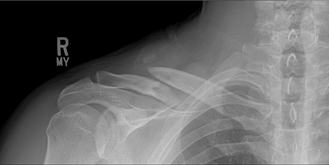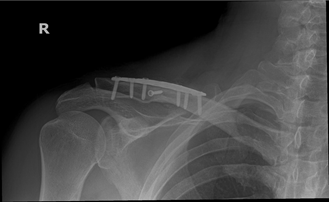Causes
For a majority of patients who sustain clavicle fractures, it occurs in the middle third of the bone from a direct impact. Symptoms include:
(1) Immediate pain
(2) A pop or crack
(3) A visual deformity of the clavicle
(4) Discoloration or swelling
(5) Tenderness over the clavicle

Diagnosis
X-rays are taken to diagnose within the first week of the injury. This will determine the position and severity of the fracture. Dr. Nicholson will examine the shoulder strength, range of motion and rule out any neurological involvement.

Non-Operative
When fractures show minimal displacement, callus formation can bridge the gap and heal naturally without surgical intervention. Patient’s will follow up on a 1-2 week basis with repeat x-rays until the fracture is fully healed.
Rest: Resting the injured joint is the first step to reduce swelling and pain. Keeping it immobilized for the first 4-6 weeks will heal the fracture.
Ice: In the first 24 hours of an injury, ice it to reduce swelling and pain.
Heat: After 1 week has passed, a heating pad or hot compress can help.
NSAIDS (non-steroidal anti-inflammatory drugs): Reduce pain and swelling through NSAIDS such as ibuprofen (Advil), naproxen (Aleve), or aspirin.
Physical therapy and exercise: Gentle exercises and stretches designed to strengthen the muscles surrounding the shoulder joint after the fracture is fully healed.
Patients can expect full recovery with conservative treatment between 2-4 months.
Surgical Treatment
Fractures that show significant displacement on x-ray, for optimal healing and stability, a surgical intervention may be recommended. Dr. Nicholson would recommend an Open Reduction Internal Fixation of the clavicle. This is an open procedure involving a plate and screws custom to the patient’s clavicle to realign the bone in good position. The typical recovery to heal is between 4-6 weeks and patients should expect to attend physical therapy for up to 12 weeks. Patients should expect to gain full range of motion and strength with in 3-5 months. The complication rate for this procedure is less than 1% including neurological deficits and hardware malfunction.
A.) Significant displacement with no bone contact minimizing the probability of natural callus formation or healing.

B.) ORIF Clavicle providing excellent bone alignment to allow callus formation and healing.

